A Compact Mu-Near-Zero Metamaterial Integrated Wideband High-Gain MIMO Antenna for 5G New Radio Applications
Abstract
1. Introduction
2. MM-Based Reflector
3. MIMO Antenna Design and Analysis with MM
3.1. Single Antenna Design
3.2. MIMO Antenna Design with MM
4. Results and Discussion
4.1. Reflection Coefficients and Isolation
4.2. Gain and Efficiency
4.3. Radiation Patterns
4.4. Envelope Correlation Coefficient (ECC)
4.5. Diversity Gain (DG)
4.6. Channel Capacity Loss (CCL)
4.7. Multiplexing Efficiency (ME)
5. Performance Comparison with Relevant Works
6. Conclusions
Author Contributions
Funding
Institutional Review Board Statement
Informed Consent Statement
Data Availability Statement
Acknowledgments
Conflicts of Interest
References
- Du, Z.; Feng, Q. Gain Improvement and Front-to-Back Ratio Enhancement for Substrate-Integrated Magnetoelectric Dipole Antenna. IEEE Antennas Wirel. Propag. Lett. 2021, 21, 59–63. [Google Scholar] [CrossRef]
- Wang, C.; Wang, H.; Wu, P.; Hou, M. Dual-Band Closed-Slot MIMO Antenna for Terminal Wireless Applications. IEEE Trans. Antennas Propag. 2022, 70, 6514–6525. [Google Scholar] [CrossRef]
- Chen, C. A Wideband Coplanar L-probe Fed Slot-loaded Rectangular Filtering Microstrip Patch Antenna with High Selectivity. IEEE Antennas Wirel. Propag. Lett. 2022, 21, 1134–1138. [Google Scholar] [CrossRef]
- de Dieu Ntawangaheza, J.; Sun, L.; Wang, S.; Li, Y.; Zheng, Z.; Biao, D.; Rushingabigwi, G. A Single-Layer Low-Profile Broadband Metasurface-Inspired Antenna with Monopole-Like Radiation Characteristics. IEEE Trans. Antennas Propag. 2021, 70, 4818–4823. [Google Scholar] [CrossRef]
- Zhang, J.; Yan, S.; Hu, X.; Vandenbosch, G.A. Mutual coupling suppression for on-body multiantenna systems. IEEE Trans. Electromagn. Compat. 2019, 62, 1045–1054. [Google Scholar] [CrossRef]
- Yang, B.; Xu, Y.; Tong, J.; Zhang, Y.; Feng, Y.; Hu, Y. Tri-port Antenna with Shared Radiator and Self-decoupling Characteristic for 5G Smartphone Applications. IEEE Trans. Antennas Propag. 2021, 70, 4836–4841. [Google Scholar] [CrossRef]
- Zhang, Y.; Deng, J.-Y.; Li, M.-J.; Sun, D.; Guo, L.-X. A MIMO dielectric resonator antenna with improved isolation for 5G mm-wave applications. IEEE Antennas Wirel. Propag. Lett. 2019, 18, 747–751. [Google Scholar] [CrossRef]
- Chang, L.; Zhang, G.; Wang, H. Triple-band microstrip patch antenna and its four-antenna module based on half-mode patch for 5G 4× 4 MIMO operation. IEEE Trans. Antennas Propag. 2021, 70, 67–74. [Google Scholar] [CrossRef]
- Tran, H.-H.; Hussain, N.; Park, H.C.; Nguyen-Trong, N. Isolation in Dual-Sense CP MIMO Antennas and Role of Decoupling Structures. IEEE Antennas Wirel. Propag. Lett. 2022, 21, 1203–1207. [Google Scholar] [CrossRef]
- Iqbal, A.; Smida, A.; Alazemi, A.J.; Waly, M.I.; Mallat, N.K.; Kim, S. Wideband circularly polarized MIMO antenna for high data wearable biotelemetric devices. IEEE Access 2020, 8, 17935–17944. [Google Scholar] [CrossRef]
- Garg, P.; Jain, P. Isolation improvement of MIMO antenna using a novel flower shaped metamaterial absorber at 5.5 GHz WiMAX band. IEEE Trans. Circuits Syst. II: Express Briefs 2019, 67, 675–679. [Google Scholar] [CrossRef]
- Sufian, M.A.; Hussain, N.; Askari, H.; Park, S.G.; Shin, K.S.; Kim, N. Isolation enhancement of a metasurface-based MIMO antenna using slots and shorting pins. IEEE Access 2021, 9, 73533–73543. [Google Scholar] [CrossRef]
- Ameen, M.; Ahmad, O.; Chaudhary, R. Wideband circularly-polarised high-gain diversity antenna loaded with metasurface reflector for small satellite applications. Electron. Lett. 2019, 55, 829–831. [Google Scholar] [CrossRef]
- Fan, T.-Q.; Jiang, B.; Liu, R.; Xiu, J.; Lin, Y.; Xu, H. A Novel Double U-Slot Microstrip Patch Antenna Design for Low-Profile and Broad Bandwidth Applications. IEEE Trans. Antennas Propag. 2021, 70, 2543–2549. [Google Scholar] [CrossRef]
- Hussine, U.U.; Islam, M.T.; Misran, N. Analysis of microstrip patch antenna for L1 and L2 for global positioning system applications. Jurnal Kejuruteraan 2013, 24, 29–33. [Google Scholar]
- Chowdhury, M.Z.B.; Islam, M.T.; Rmili, H.; Hossain, I.; Mahmud, M.Z.; Samsuzzaman, M. A low-profile rectangular slot antenna for sub-6 GHz 5G wireless applications. Int. J. Commun. Syst. 2022, 35, e5321. [Google Scholar] [CrossRef]
- Liu, F.; Guo, J.; Zhao, L.; Huang, G.-L.; Li, Y.; Yin, Y. Dual-band metasurface-based decoupling method for two closely packed dual-band antennas. IEEE Trans. Antennas Propag. 2019, 68, 552–557. [Google Scholar] [CrossRef]
- Mark, R.; Rajak, N.; Mandal, K.; Das, S. Metamaterial based superstrate towards the isolation and gain enhancement of MIMO antenna for WLAN application. AEU-Int. J. Electron. Commun. 2019, 100, 144–152. [Google Scholar] [CrossRef]
- Babu, K.V.; Das, S.; Sree, G.N.J.; Patel, S.K.; Saradhi, M.P.; Tagore, M. Design and development of miniaturized MIMO antenna using parasitic elements and Machine learning (ML) technique for lower sub 6 GHz 5G applications. AEU-Int. J. Electron. Commun. 2022, 153, 154281. [Google Scholar] [CrossRef]
- Xiong, H.Q.; Zhang, C.J.; Tong, M.S. Wideband Low-Profile Dual-Polarized Antenna Based on a Gain-Enhanced EBG Reflector. IEEE Trans. Compon. Packag. Manuf. Technol. 2021, 12, 391–394. [Google Scholar] [CrossRef]
- Khan, A.; Bashir, S.; Ghafoor, S.; Qureshi, K.K. Mutual coupling reduction using ground stub and EBG in a compact wideband MIMO-antenna. IEEE Access 2021, 9, 40972–40979. [Google Scholar] [CrossRef]
- Yang, R.; Xi, S.; Cai, Q.; Chen, Z.; Wang, X.; Liu, G. A compact planar dual-band multiple-input and multiple-output antenna with high isolation for 5G and 4G applications. Micromachines 2021, 12, 544. [Google Scholar] [CrossRef] [PubMed]
- Wang, Z.; Li, C.; Wu, Q.; Yin, Y. A metasurface-based low-profile array decoupling technology to enhance isolation in MIMO antenna systems. IEEE Access 2020, 8, 125565–125575. [Google Scholar] [CrossRef]
- Panda, P.K.; Ghosh, D. Isolation and gain enhancement of patch antennas using EMNZ superstrate. AEU-Int. J. Electron. Commun. 2018, 86, 164–170. [Google Scholar] [CrossRef]
- Hasan, M.M.; Islam, M.T.; Moniruzzaman, M.; Soliman, M.S.; Alshammari, A.S.; Sulayman, I.I.M.A.; Samsuzzaman, M.; Islam, M.S. Symmetric Engineered High Polarization-Insensitive Double Negative Metamaterial Reflector for Gain and Directivity Enhancement of Sub-6 GHz 5G Antenna. Materials 2022, 15, 5676. [Google Scholar] [CrossRef] [PubMed]
- Liu, Y.; Yang, X.; Jia, Y.; Guo, Y.J. A low correlation and mutual coupling MIMO antenna. IEEE Access 2019, 7, 127384–127392. [Google Scholar] [CrossRef]
- Hasan, M.; Islam, M.T.; Almalki, S.H.; Alharbi, A.G.; Alsaif, H.; Islam, M.; Samsuzzaman, M. Polarization insensitive dual band metamaterial with absorptance for 5G sub-6 GHz applications. Sci. Rep. 2022, 12, 1–20. [Google Scholar]
- Moniruzzaman, M.; Islam, M.T.; Mansor, M.F.; Soliman, M.S.; Misran, N.; Samsuzzaman, M. Tuning metallic stub loaded symmetrical resonator based dual band metamaterial absorber for wave shielding from Wi-Fi frequencies. Alex. Eng. J. 2022, 63, 399–414. [Google Scholar] [CrossRef]
- Khan, I.; Zhang, K.; Wu, Q.; Ullah, I.; Ali, L.; Ullah, H.; Rahman, S.U. A Wideband High-Isolation Microstrip MIMO Circularly-Polarized Antenna Based on Parasitic Elements. Materials 2023, 16, 103. [Google Scholar] [CrossRef]
- Iqbal, A.; Saraereh, A.O.; Bouazizi, A.; Basir, A. Metamaterial-based highly isolated MIMO antenna for portable wireless applications. Electronics 2018, 7, 267. [Google Scholar] [CrossRef]
- Sakli, H.; Abdelhamid, C.; Essid, C.; Sakli, N. Metamaterial-based antenna performance enhancement for MIMO system applications. IEEE Access 2021, 9, 38546–38556. [Google Scholar] [CrossRef]
- Moussa, K.H.; Amar, A.S.; Mabrouk, M.; Mohamed, H.G. Slotted E-shaped meta-material decoupling slab for densely packed MIMO antenna arrays. Micromachines 2021, 12, 873. [Google Scholar] [CrossRef] [PubMed]
- Tang, J.; Faraz, F.; Chen, X.; Zhang, Q.; Li, Q.; Li, Y.; Zhang, S. A metasurface superstrate for mutual coupling reduction of large antenna arrays. IEEE Access 2020, 8, 126859–126867. [Google Scholar] [CrossRef]
- Ojo, R.; Jamlos, M.F.; Soh, P.J.; Jamlos, M.A.; Bahari, N.; Lee, Y.S.; Al-Bawri, S.S.; Abdul Karim, M.S.; Khairi, K.A. A triangular MIMO array antenna with a double negative metamaterial superstrate to enhance bandwidth and gain. Int. J. RF Microw. Comput. Aided Eng. 2020, 30, e22320. [Google Scholar] [CrossRef]
- Mark, R.; Singh, H.V.; Mandal, K.; Das, S. Mutual coupling reduction using near-zero ε and μ metamaterial-based superstrate for an MIMO application. IET Microw. Antennas Propag. 2020, 14, 479–484. [Google Scholar] [CrossRef]
- Zhang, J.; Han, L.; Chen, X.; Yang, R.; Zhang, W. Multi-beam patch antenna based on metasurface. IEEE Access 2019, 8, 37281–37286. [Google Scholar] [CrossRef]
- Ameen, M.; Ahmad, O.; Chaudhary, R.K. Bandwidth and gain enhancement of triple-band MIMO antenna incorporating metasurface-based reflector for WLAN/WiMAX applications. IET Microw. Antennas Propag. 2020, 14, 1493–1503. [Google Scholar] [CrossRef]
- Costa, F.; Luukkonen, O.; Simovski, C.R.; Monorchio, A.; Tretyakov, S.A.; de Maagt, P.M. TE surface wave resonances on high-impedance surface based antennas: Analysis and modeling. IEEE Trans. Antennas Propag. 2011, 59, 3588–3596. [Google Scholar] [CrossRef]
- Al-Bawri, S.S.; Islam, M.T.; Shabbir, T.; Muhammad, G.; Islam, M.S.; Wong, H.Y. Hexagonal shaped near zero index (NZI) metamaterial based MIMO antenna for millimeter-wave application. IEEE Access 2020, 8, 181003–181013. [Google Scholar] [CrossRef]
- Alam, T.; Islam, M.T.; Cho, M. Near-zero metamaterial inspired UHF antenna for nanosatellite communication system. Sci. Rep. 2019, 9, 1–15. [Google Scholar] [CrossRef]
- Wu, Z.; Li, L.; Li, Y.; Chen, X. Metasurface superstrate antenna with wideband circular polarization for satellite communication application. IEEE Antennas Wirel. Propag. Lett. 2015, 15, 374–377. [Google Scholar] [CrossRef]
- Bait-Suwailam, M.M. Electromagnetic field interaction with metamaterials. Electromagn. Fields Waves 2019, 1–19. [Google Scholar] [CrossRef]
- Li, D.; Szabó, Z.; Qing, X.; Li, E.-P.; Chen, Z.N. A high gain antenna with an optimized metamaterial inspired superstrate. IEEE Trans. Antennas Propag. 2012, 60, 6018–6023. [Google Scholar] [CrossRef]
- Chen, X.; Grzegorczyk, T.M.; Wu, B.-I.; Pacheco Jr, J.; Kong, J.A. Robust method to retrieve the constitutive effective parameters of metamaterials. Phys. Rev. E 2004, 70, 016608. [Google Scholar] [CrossRef] [PubMed]
- Liberal, I.; Engheta, N. Near-zero refractive index photonics. Nat. Photonics 2017, 11, 149–158. [Google Scholar] [CrossRef]
- Borazjani, O.; Naser-Moghadasi, M.; Rashed-Mohassel, J.; Sadeghzadeh, R. Design and fabrication of a new high gain multilayer negative refractive index metamaterial antenna for X-band applications. Int. J. RF Microw. Comput. Aided Eng. 2020, 30, e22284. [Google Scholar] [CrossRef]
- Dadgarpour, A.; Zarghooni, B.; Virdee, B.S.; Denidni, T.A.; Kishk, A.A. Mutual coupling reduction in dielectric resonator antennas using metasurface shield for 60-GHz MIMO systems. IEEE Antennas Wirel. Propag. Lett. 2016, 16, 477–480. [Google Scholar] [CrossRef]
- Abdelaziem, I.H.; Ibrahim, A.A.; Abdalla, M.A. A high gain antenna utilizing Mu-near-zero metasurface structures for 5G applications. Int. J. Microw. Wirel. Technol. 2022, 1–9. [Google Scholar] [CrossRef]
- Balanis, C.A. Antenna Theory: Analysis and Design; John Wiley & Sons: Hoboken, NJ, USA, 2015. [Google Scholar]
- Alam, T.; Almutairi, A.F.; Samsuzzaman, M.; Cho, M.; Islam, M.T. Metamaterial array based meander line planar antenna for cube satellite communication. Sci. Rep. 2021, 11, 1–12. [Google Scholar] [CrossRef]
- Asif, M.; Sehrai, D.A.; Kiani, S.H.; Khan, J.; Abdullah, M.; Ibrar, M.; Alibakhshikenari, M.; Falcone, F.; Limiti, E. Design of a dual band SNG metamaterial based antenna for LTE 46/WLAN and Ka-band applications. IEEE Access 2021, 9, 71553–71562. [Google Scholar] [CrossRef]
- Nahar, T.; Rawat, S. Efficiency enhancement techniques of microwave and millimeter-wave antennas for 5G communication: A survey. Trans. Emerg. Telecommun. Technol. 2022, 33, e4530. [Google Scholar] [CrossRef]
- Khan, A.; Nema, R. Analysis of five different dielectric substrates on microstrip patch antenna. Int. J. Comput. Appl. 2012, 55, 40–47. [Google Scholar] [CrossRef]
- Sarrazin, F.; Pflaum, S.; Delaveaud, C. Radiation efficiency improvement of a balanced miniature IFA-inspired circular antenna. IEEE Antennas Wirel. Propag. Lett. 2016, 16, 1309–1312. [Google Scholar] [CrossRef]
- Hussain, N.; Jeong, M.-J.; Abbas, A.; Kim, N. Metasurface-based single-layer wideband circularly polarized MIMO antenna for 5G millimeter-wave systems. IEEE Access 2020, 8, 130293–130304. [Google Scholar] [CrossRef]
- Sharawi, M.S. Printed multi-band MIMO antenna systems and their performance metrics [wireless corner]. IEEE Antennas Propag. Mag. 2013, 55, 218–232. [Google Scholar] [CrossRef]
- See, C.H.; Abd-Alhameed, R.A.; Abidin, Z.Z.; McEwan, N.J.; Excell, P.S. Wideband printed MIMO/diversity monopole antenna for WiFi/WiMAX applications. IEEE Trans. Antennas Propag. 2012, 60, 2028–2035. [Google Scholar] [CrossRef]
- Supreeyatitikul, N.; Phungasem, A.; Aeimopas, P. Design of wideband sub-6 GHz 5G MIMO antenna with isolation enhancement using an MTM-inspired resonators. In Proceedings of the 2021 Joint International Conference on Digital Arts, Media and Technology with ECTI Northern Section Conference on Electrical, Electronics, Computer and Telecommunication Engineering, Cha-am, Thailand, 3–6 March 2021; pp. 206–209. [Google Scholar]
- Jehangir, S.S.; Sharawi, M.S. A compact single-layer four-port orthogonally polarized Yagi-like MIMO antenna system. IEEE Trans. Antennas Propag. 2020, 68, 6372–6377. [Google Scholar] [CrossRef]
- Kim, Y.S.; Cho, D.-H. Design of four-port integrated monopole antenna using refraction effect of dielectric medium for pattern gain enhancement. IEEE Antennas Wirel. Propag. Lett. 2020, 19, 621–625. [Google Scholar] [CrossRef]
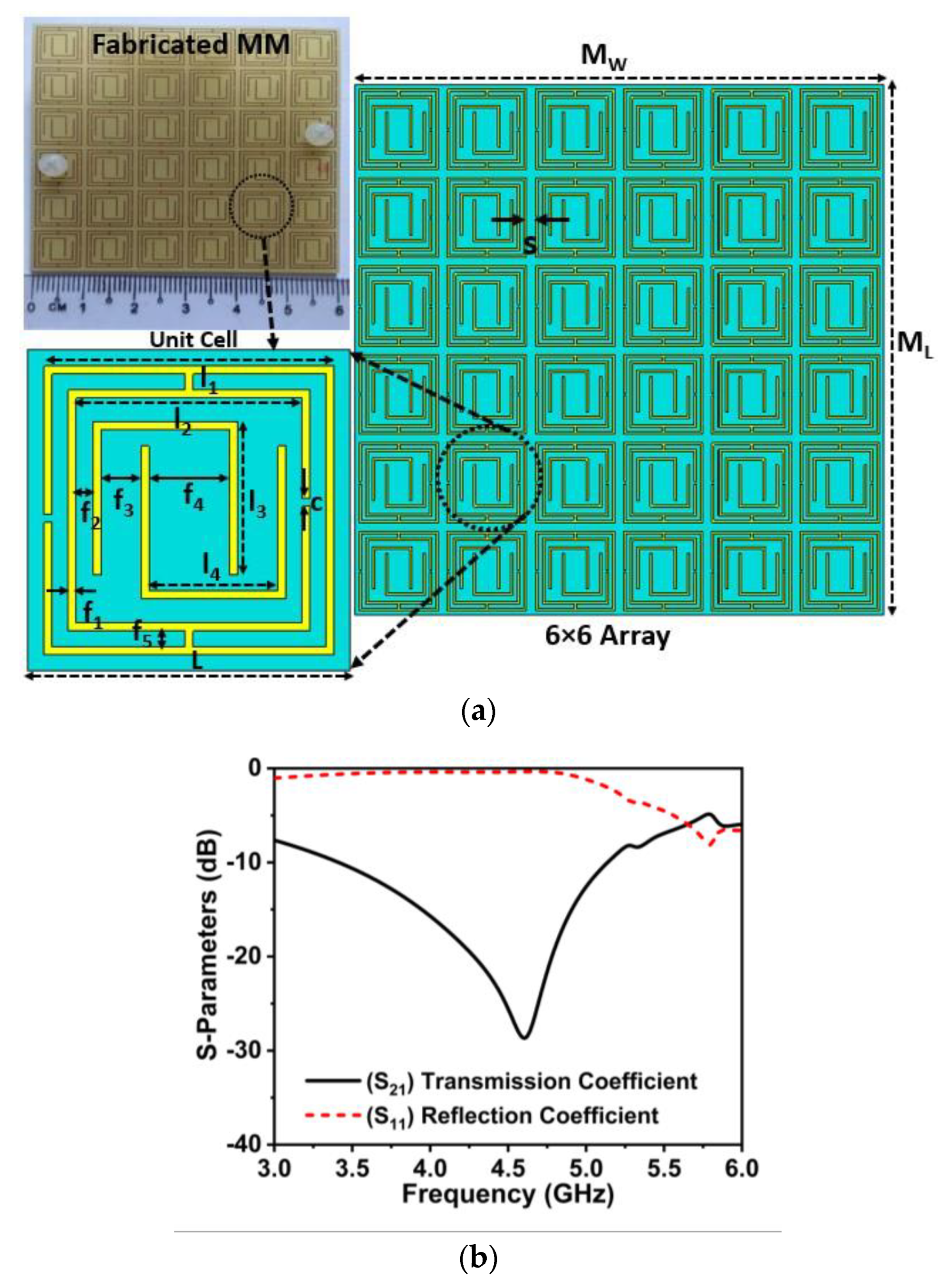
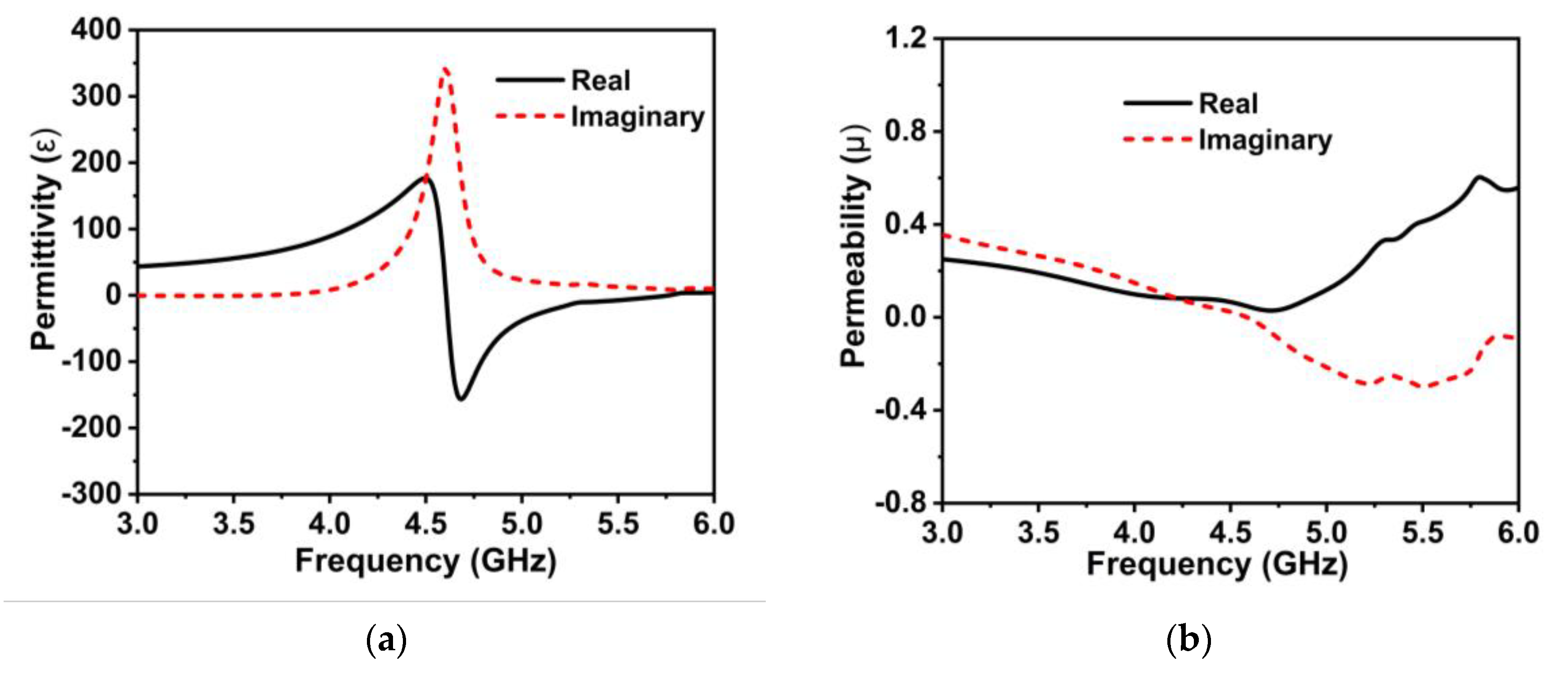
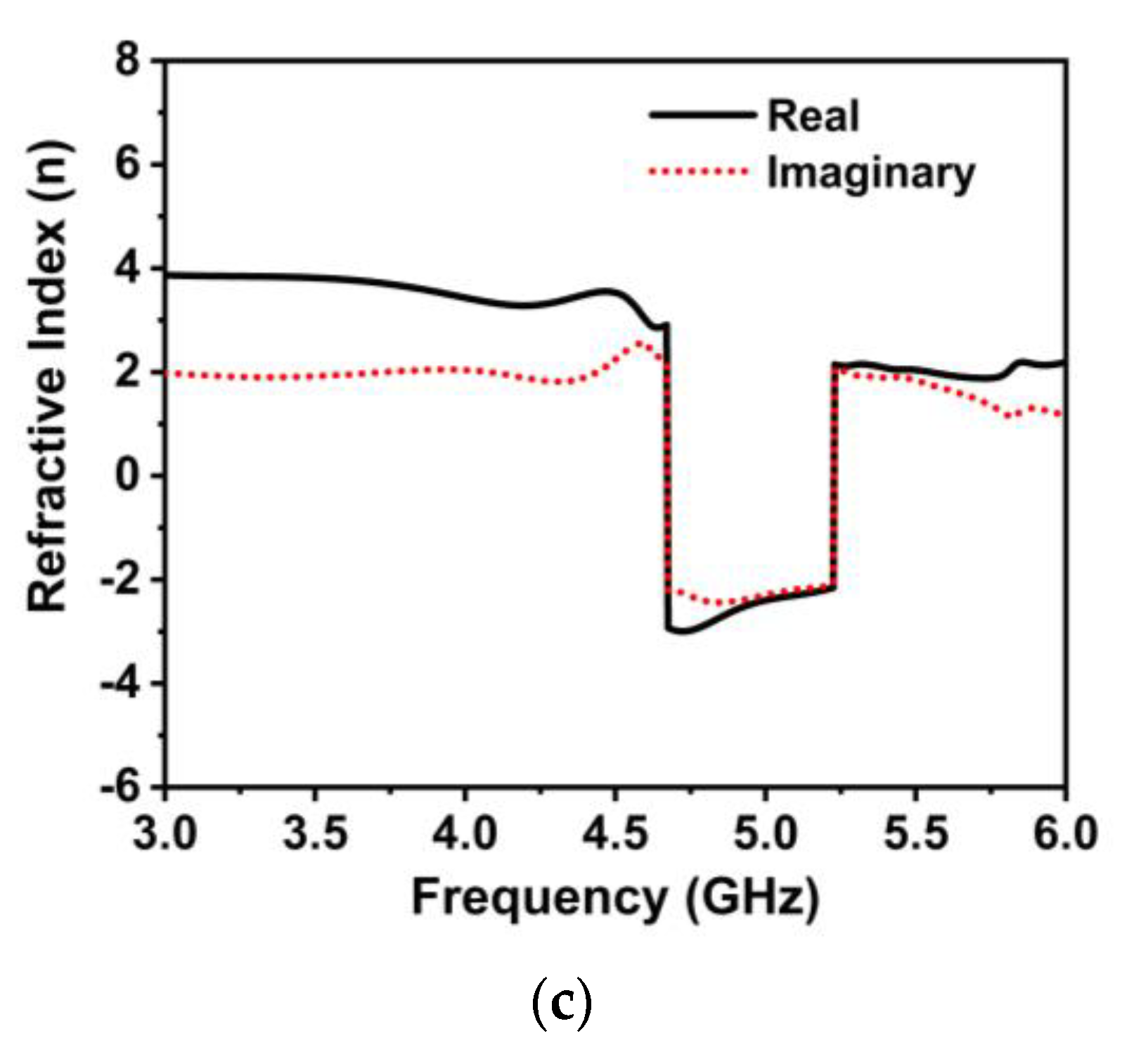


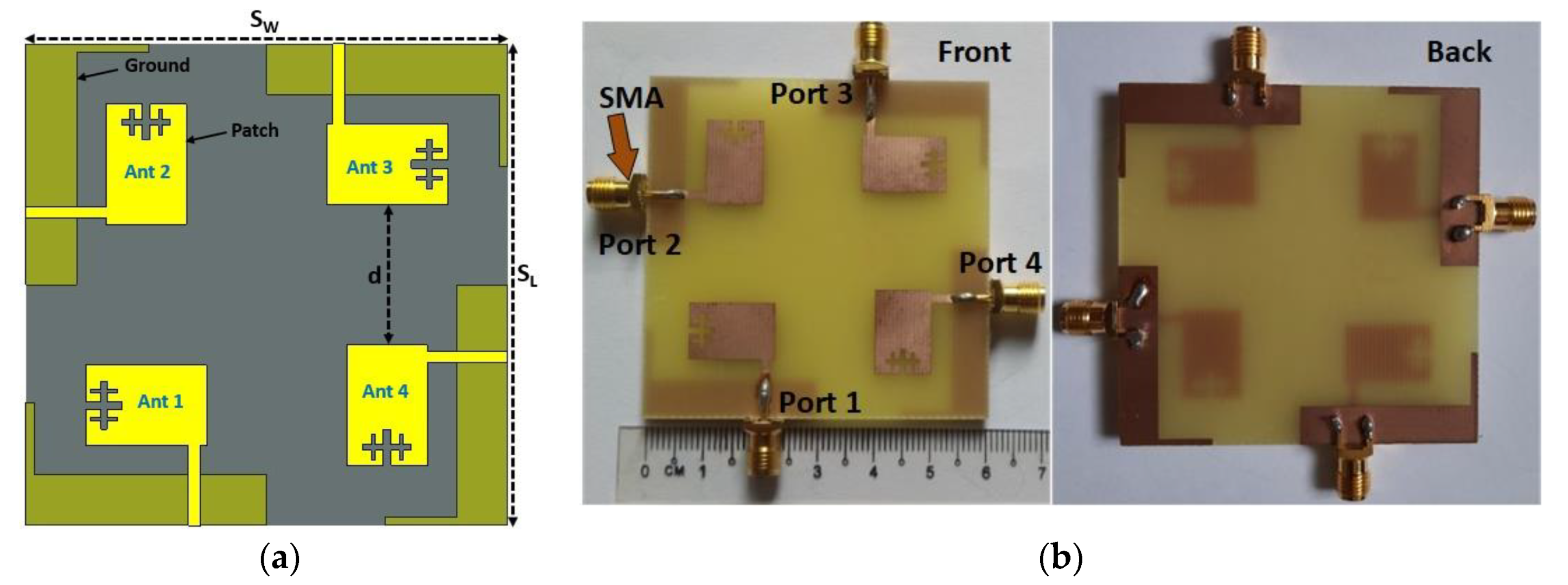
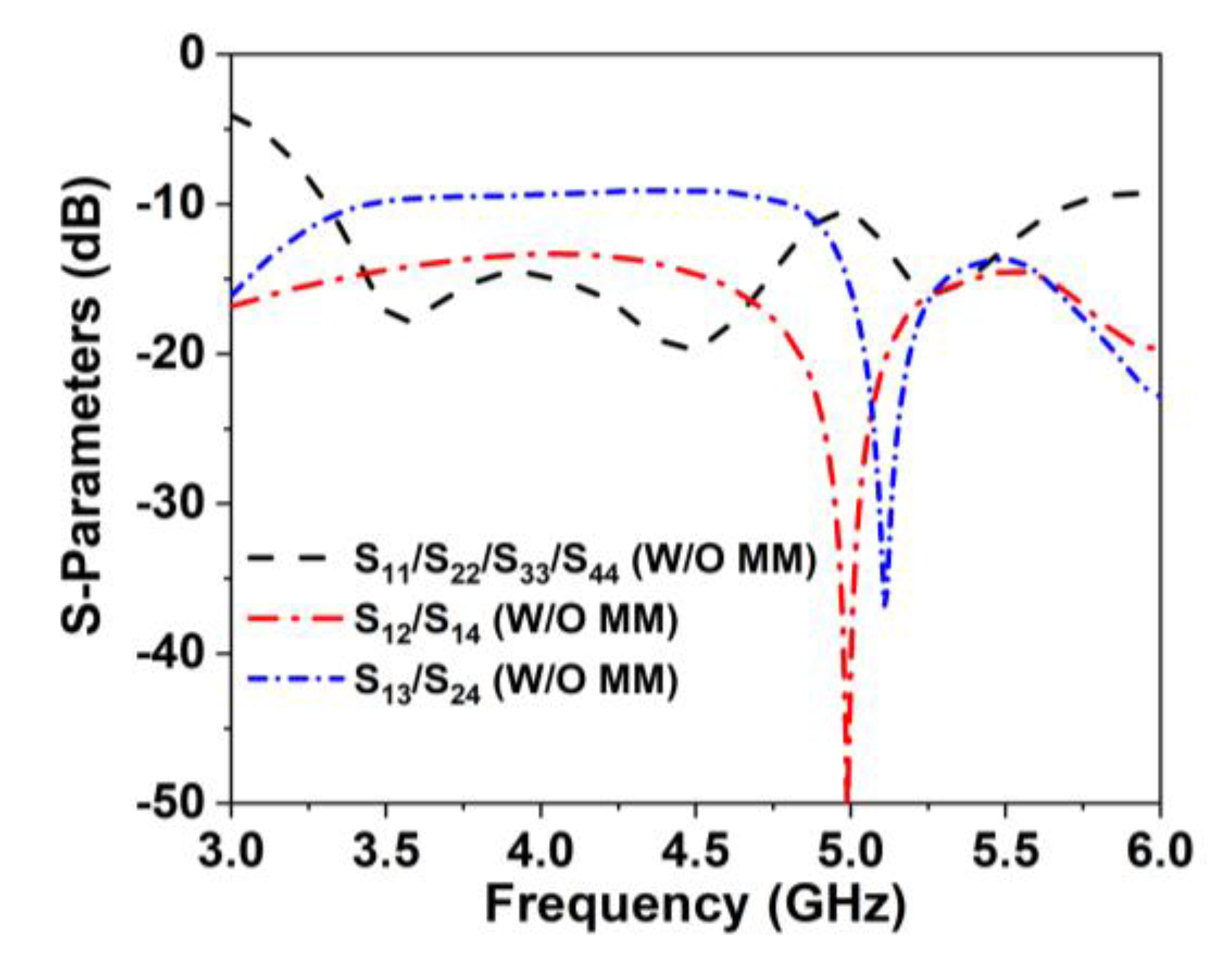

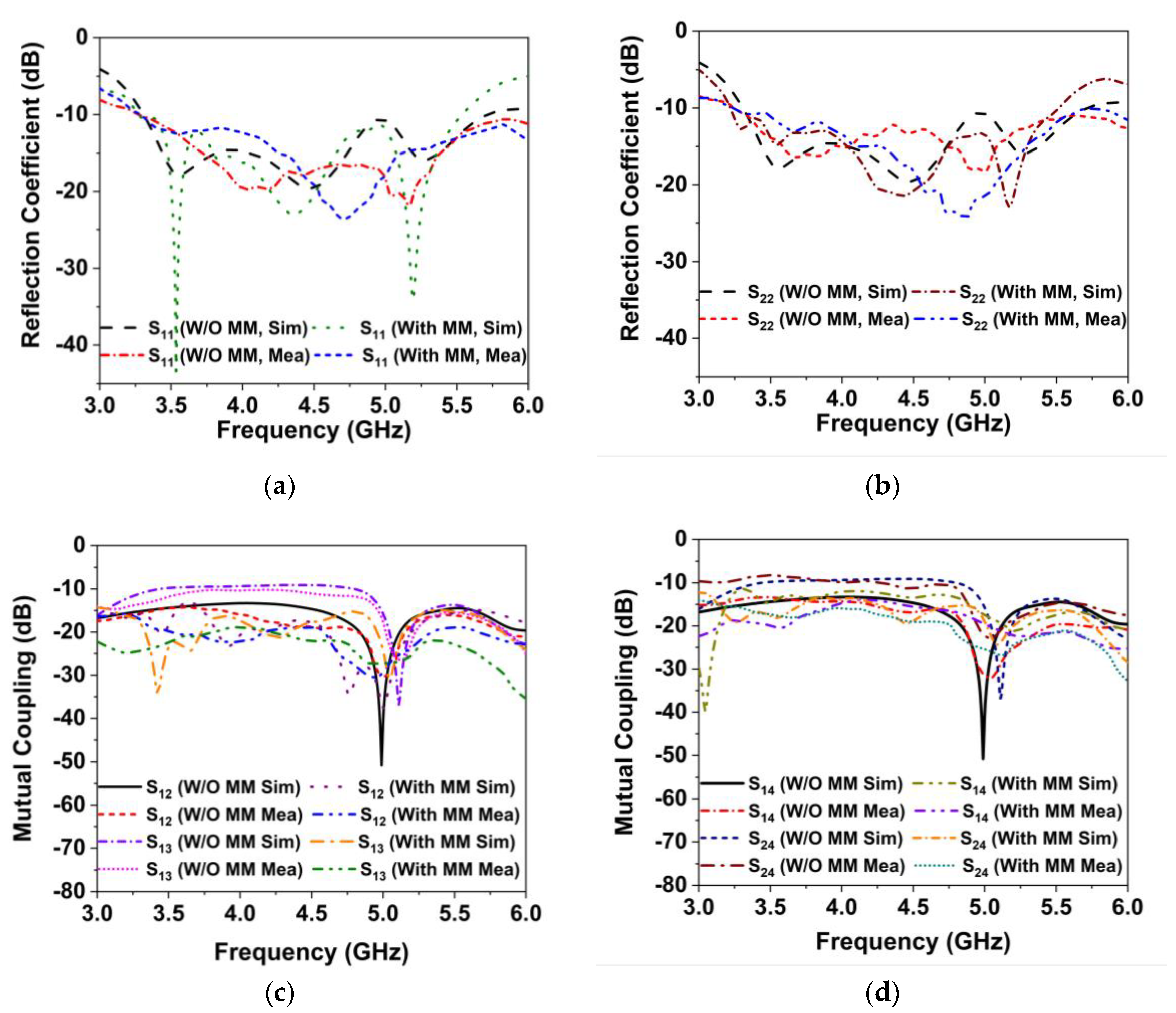
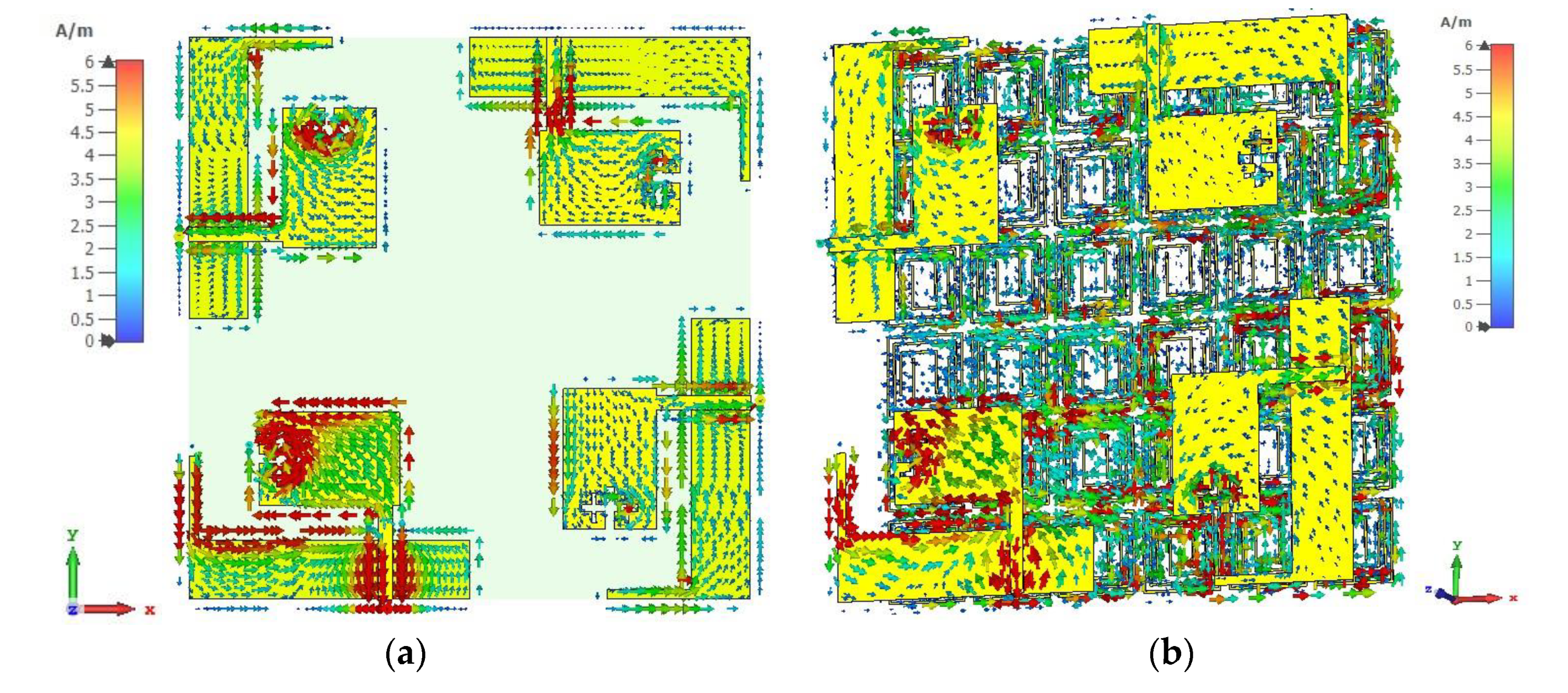
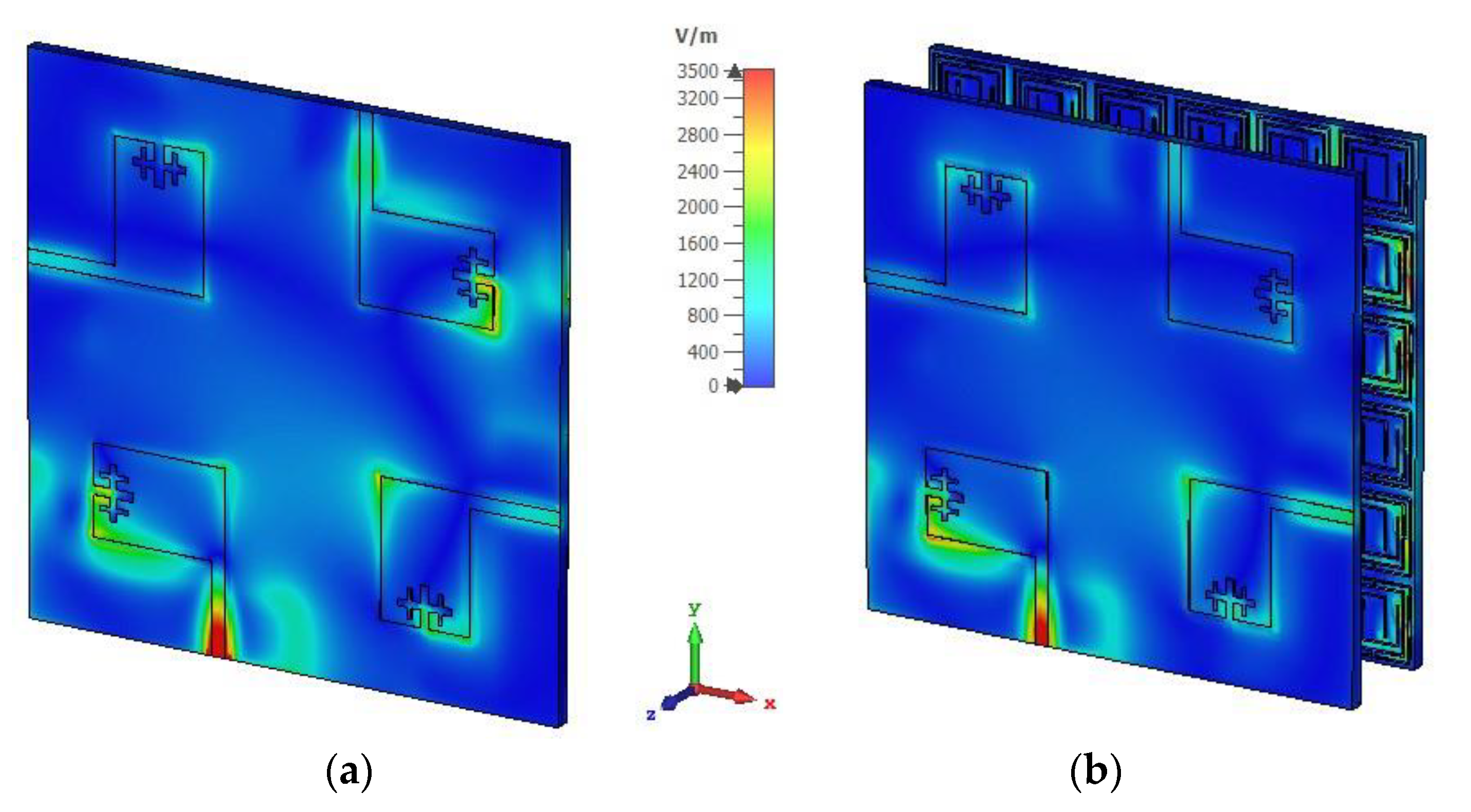

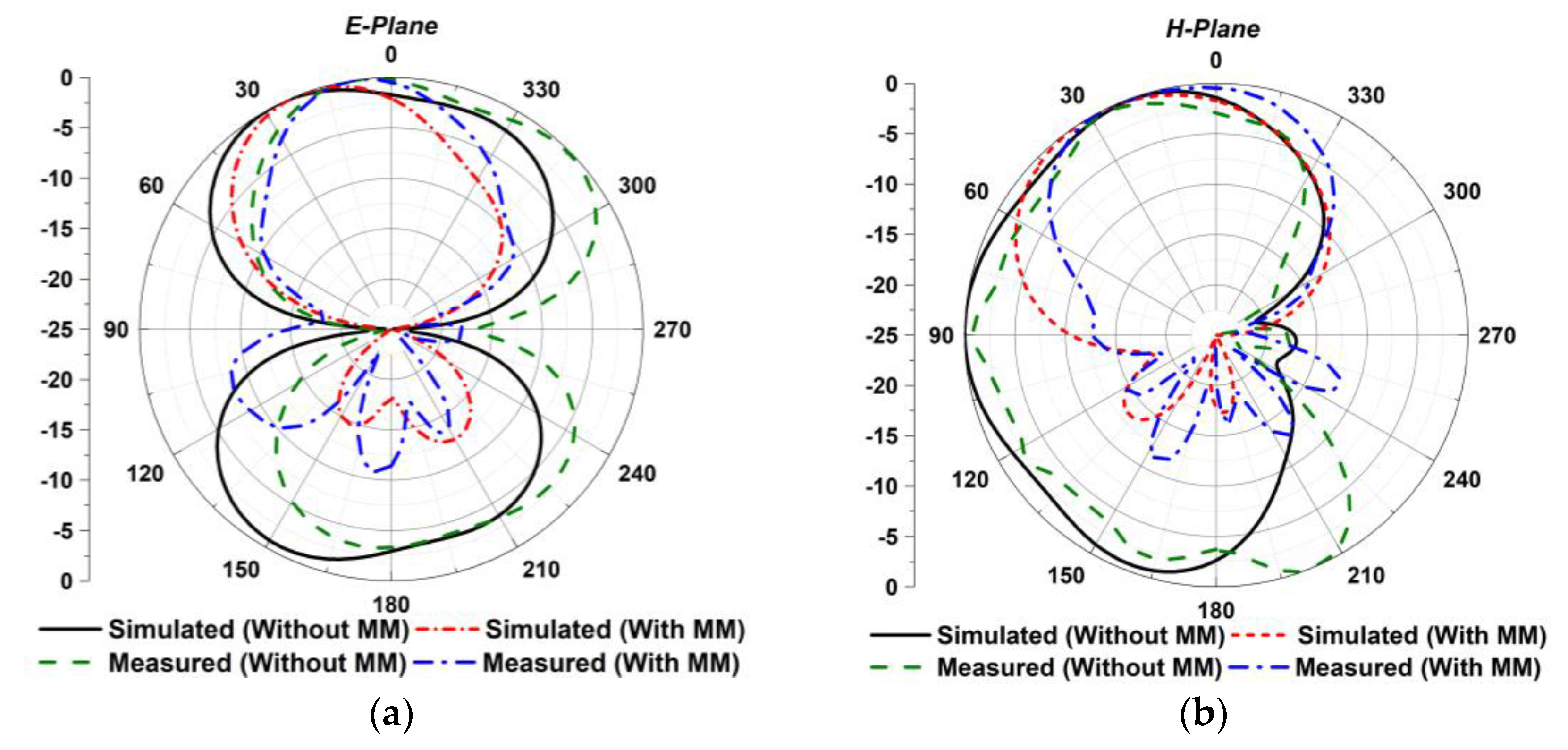

| Ref. | Dimension (λmin) | Elements | Antenna Structure | Bandwidth (GHz) (%) | Gain Improvement (dB) | Max. Gain (dBi) | ECC (dB) | DG (dB) | CCL (bps/Hz) |
|---|---|---|---|---|---|---|---|---|---|
| [13] | 0.62 × 0.62 × 0.11 | 2 | MIMO + MS | (2.23–2.91) 26.45 | 6 | 7.02 | Not Given | Not Given | Not Given |
| [59] | 0.38 × 0.98 × 0.008 | 4 | MIMO | (3.26–3.88) 17.42 | - | 4 | <0.10 | Not Given | Not Given |
| [60] | 0.46 × 0.46 × 0.19 | 4 | MIMO + MM Reflector | (2.28–2.52) 9.58 | - | 6 | <0.19 | Not Given | Not Given |
| [12] | 1.6 × 1.6 × 0.04 | 4 | MIMO + MS | (3.3–3.87) 15.9 | 0.6 | 8.72 | <0.001 | >9.98 | Not Given |
| [58] | 0.36 × 0.66 × 0.02 | 2 | MIMO + MM | (3.0–6.0) 70.7 | 0.8 | 3.28 | <0.02 | >9.95 | Not Given |
| This Paper | 0.65 × 0.65 × 0.14 | 4 | MIMO+MM | (3.25–5.6) 55.2 | 2.8 | 7.10 | <0.008 (SP)<0.045 (RP) | >9.96 | <0.35 |
Disclaimer/Publisher’s Note: The statements, opinions and data contained in all publications are solely those of the individual author(s) and contributor(s) and not of MDPI and/or the editor(s). MDPI and/or the editor(s) disclaim responsibility for any injury to people or property resulting from any ideas, methods, instructions or products referred to in the content. |
© 2023 by the authors. Licensee MDPI, Basel, Switzerland. This article is an open access article distributed under the terms and conditions of the Creative Commons Attribution (CC BY) license (https://creativecommons.org/licenses/by/4.0/).
Share and Cite
Hasan, M.M.; Islam, M.T.; Rahim, S.K.A.; Alam, T.; Rmili, H.; Alzamil, A.; Islam, M.S.; Soliman, M.S. A Compact Mu-Near-Zero Metamaterial Integrated Wideband High-Gain MIMO Antenna for 5G New Radio Applications. Materials 2023, 16, 1751. https://doi.org/10.3390/ma16041751
Hasan MM, Islam MT, Rahim SKA, Alam T, Rmili H, Alzamil A, Islam MS, Soliman MS. A Compact Mu-Near-Zero Metamaterial Integrated Wideband High-Gain MIMO Antenna for 5G New Radio Applications. Materials. 2023; 16(4):1751. https://doi.org/10.3390/ma16041751
Chicago/Turabian StyleHasan, Md. Mhedi, Mohammad Tariqul Islam, Sharul Kamal Abdul Rahim, Touhidul Alam, Hatem Rmili, Ahmed Alzamil, Md. Shabiul Islam, and Mohamed S. Soliman. 2023. "A Compact Mu-Near-Zero Metamaterial Integrated Wideband High-Gain MIMO Antenna for 5G New Radio Applications" Materials 16, no. 4: 1751. https://doi.org/10.3390/ma16041751
APA StyleHasan, M. M., Islam, M. T., Rahim, S. K. A., Alam, T., Rmili, H., Alzamil, A., Islam, M. S., & Soliman, M. S. (2023). A Compact Mu-Near-Zero Metamaterial Integrated Wideband High-Gain MIMO Antenna for 5G New Radio Applications. Materials, 16(4), 1751. https://doi.org/10.3390/ma16041751







